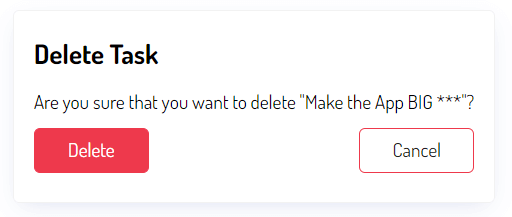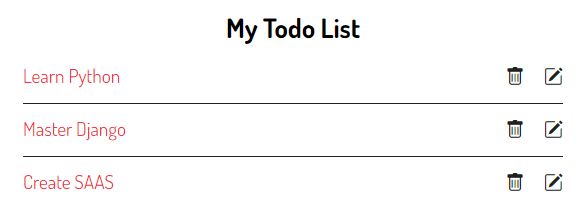Summary: in this tutorial, you’ll learn how to use the Django DeleteView class to define a class-based view that deletes an existing object.
This tutorial begins where the Django UpdateView tutorial left off.
Create a Django DeleteView class #
The Django DeleteView class allows you to define a class-based view that displays a confirmation page and deletes an existing object.
If the HTTP request method is GET, the DeleteViewPOST, the DeleteView
To use the DeleteView class, you define a class that inherits from it and add attributes and methods to override the default behaviors.
For example, the following defines a TaskDelete class that deletes a task for the Todo app:
#...
from django.views.generic.edit import DeleteView, CreateView, UpdateView
from django.contrib import messages
from django.urls import reverse_lazy
from .models import Task
class TaskDelete(DeleteView):
model = Task
context_object_name = 'task'
success_url = reverse_lazy('tasks')
def form_valid(self, form):
messages.success(self.request, "The task was deleted successfully.")
return super(TaskDelete,self).form_valid(form)
#...Code language: Python (python)In this example, we define the TaskDeleteDeleteView class. The TaskDelete
modelspecifies the class of the model (Task) that will be deleted.context_object_nameDeleteViewclass uses theobjectas the name. However, you can override the name using thecontext_object_namesuccess_urlis the URL that will be redirected to once the object is deleted successfully.form_valid()
By default, the DeleteView class uses the task_confirmation_delete.html template if you don’t specify it explicitly.
Creating task_confirm_delete.html template #
Create a new file task_confirm_delete.html template in the templates/todo app with the following code:
{%extends 'base.html'%}
{%block content%}
<div class="center">
<form method="post" class="card">
{% csrf_token %}
<h2>Delete Task</h2>
<p>Are you sure that you want to delete "{{task}}"?</p>
<p class="form-buttons">
<input type="submit" class="btn btn-primary" value="Delete">
<a href="{% url 'tasks'%}" class="btn btn-outline">Cancel</a>
</p>
</form>
</div>
{%endblock content%}Code language: HTML, XML (xml)The task_confirm_delete.html extends the base.html template and contains a form that deletes a task.
Defining a route #
Define a new route in the urls.py that maps a URL that deletes a task with the result of the as_view() method of the TaskDelete view class:
from django.urls import path
from .views import (
home,
TaskList,
TaskDetail,
TaskCreate,
TaskUpdate,
TaskDelete
)
urlpatterns = [
path('', home, name='home'),
path('tasks/', TaskList.as_view(),name='tasks'),
path('task/<int:pk>/', TaskDetail.as_view(),name='task'),
path('task/create/', TaskCreate.as_view(),name='task-create'),
path('task/update/<int:pk>/', TaskUpdate.as_view(),name='task-update'),
path('task/delete/<int:pk>/', TaskDelete.as_view(),name='task-delete'),
]Code language: Python (python)Including a link to delete a task #
Modify the task_list.html template to add a link that deletes a task to each task on the task list:
{%extends 'base.html'%}
{%block content%}
<div class="center">
<h2>My Todo List</h2>
{% if tasks %}
<ul class="tasks">
{% for task in tasks %}
<li><a href="{% url 'task' task.id %}" class="{% if task.completed%}completed{%endif%}">{{ task.title }}</a>
<div class="task-controls">
<a href="{%url 'task-delete' task.id %}"><i class="bi bi-trash"></i> </a>
<a href="{%url 'task-update' task.id %}"><i class="bi bi-pencil-square"></i></a>
</div>
</li>
{% endfor %}
{% else %}
<p>🎉 Yay, you have no pending tasks! <a href="{%url 'task-create'%}">Create Task</a></p>
{% endif %}
</ul>
</div>
{%endblock content%}
Code language: HTML, XML (xml)If you click the delete button to delete a task on the list, you’ll get the following delete confirmation page:

Click the Delete button will delete the task from the database and redirect it back to the task list:

You can download the final code for this Django DeleteView tutorial here.
Summary #
- Use Django
DeleteViewclass to define a class-based view that deletes an existing object.